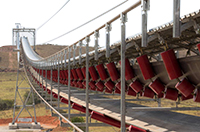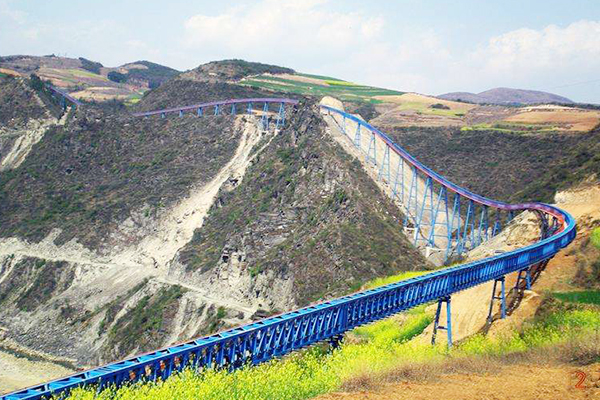Belt conveyor is the most efficient and most commonly used type of conveying machinery. It is widely used in production lines such as mines, mining, metallurgy, and ports. However, the wear of the conveyor belt has always been an important problem that plagued the development of belt conveyors. This article analyzes 4 common forms of conveyor belt wear and 6 repair treatment processes.
1 Main manifestations of conveyor belt wear
Based on long-term use and maintenance experience, the wear of the conveyor belt is mainly manifested in the following aspects.
1.1 Wear at the vulcanized joint
The wear at the vulcanized joint is generally a consequence of the material requirements of the conveyor belt. Due to its own wear resistance and thermal vulcanization quality requirements are higher than the wear resistance of the rubber layer at the joint, it is easy to cause local wear of the rubber layer at the vulcanized joint and expose the steel wire rope core or nylon core.
Generally speaking, the wear of the rubber layer at the vulcanized joint is the most common manifestation during the use of the conveyor belt, and it is also the earliest location where the conveyor belt is worn in normal use.
components of electric circuit Factory
1.2 Wear of the skirt
Improper fixing and adjustment or unreasonable design of the skirt board of the guide device will cause the skirt board to wear to the conveyor belt during work. In order to reduce the leakage of materials at the reloading part, the guide part usually uses a flexible skirt to fill the gap between the guide groove and the conveyor belt. Compared with other parts, the conveyor belt in contact with the skirt is always in relatively serious wear, which will cause more obvious wear. The main reason is that the rubber layer near the edges on both sides of the conveyor belt is severely worn, and the steel rope core or nylon core will be exposed in the longitudinal direction of the conveyor belt. Once the wire rope core is upturned, it is easy to wrap around the idler, causing serious tearing accidents and affecting the normal operation of the conveyor belt.
1.3 Wear of the middle part of the conveyor belt
The material dropping point through the funnel is relatively fixed. Generally speaking, the reprinted material always falls relatively concentratedly to the middle part of the downstream conveyor belt, which in turn gives this part a certain amount of wear. This kind of wear is actually the most conventional fixed wear of the conveyor belt.
The wear of the middle part of the conveyor belt generally has two consequences:
One is that the parts of the conveyor belt in the running direction are severely worn, causing the internal wire rope core to fall off or the conveyor belt to break;
The second is to reduce the strength of the middle part of the conveyor belt and cause a dangerous phenomenon of "discount".
1.4 Abrasion of the anti-tear mesh
At present, the conveyor belts produced by some manufacturers are tear-proof. In fact, it is to add a horizontally arranged thinner wire rope core (called anti-tear net) at a certain distance (usually 10~30m) above the steel wire rope core arranged longitudinally on the ordinary conveyor belt, locally Enhance the longitudinal strength of the conveyor belt to enhance its longitudinal tear resistance.
However, the addition of this section of anti-tear layer is actually equivalent to reducing the thickness of the glue layer there. In long-term use, the part with the tear-resistant net will wear out before the other parts of the conveyor belt. Due to the thinning of the glue layer, the transverse steel wire at the tear-resistant mesh will stretch the conveyor belt transversely, causing longitudinal protrusions. This protrusion will aggravate the wear, and the longitudinal steel cord core of the conveyor belt will be exposed, affecting the conveyor belt Normal use.
2 Treatment countermeasures for conveyor belt wear
Considering the relationship of cost, the following countermeasures are generally adopted for the conveyor belt with local wear.
2.1 Cold splash repair process
Cold splash is to use TS919 super rubber repair agent to repair the damage of the conveyor belt. This method is very effective for general conveyor belt aging and local wear. It is usually used to repair and reinforce the rubber layer of vulcanized joints, and to repair local worn parts of conveyor belts.
However, the area of ŌĆŗŌĆŗthe damaged conveyor belt is not large. Usually, the conveyor belt area that can be filled and repaired by a set of TS919 repair agent is only about 0.5 square meters. When repairing, first use a sander to clean the cold splashed parts. After cleaning, apply TS2000 cold glue twice. When the cold glue does not stick to your hands, perform the cold splashing of TS919 glue. Generally, the strength can be reached after 30 minutes.
2.2 Cold stick repair process
Compared with the cold-spray process, the cold-bonding process only replaces the cold-spray glue with a cold-bonded strip. This kind of repair process is relatively cold and can be used for emergency repair of a large area of ŌĆŗŌĆŗconveyor belt damage, and the cold-bonded strip is a processed product, and it does not require passivation after being bonded, and the maintenance time is shorter.
The disadvantage is that the penetration damage of the conveyor belt cannot be repaired, and the thickness of the cold bonding strip is fixed. After the cold bonding is completed, the local thickness of the conveyor belt will be changed, which affects the use effect of cleaning equipment such as cleaners.
2.3 Partial vulcanization process
This process is a process of using vulcanization equipment to re-vulcanize and glue the local wear parts. First remove the rubber layer at the part to be vulcanized until the core layer is completely exposed, then refill the rubber and heat it to shape it. This process can completely restore the performance of the worn parts of the conveyor belt, and make it reach (or exceed) the use strength of the factory. It is the most thorough conveyor belt repair process.
However, the repair process is complicated, requires a lot of manpower, and the repair time is long, and the repair area cannot be larger than the surface area of ŌĆŗŌĆŗthe vulcanized plate. It needs to be heated to above 150Ōäā during vulcanization, which can accelerate the aging damage to the rubber layer of the original conveyor belt. Therefore, the conveyor belt at the same location can only be vulcanized once, and secondary vulcanization is not allowed.
2.4 De-head vulcanization process
For the wear of the joints of the conveyor belt, when the partial repair process is not effective and the total length of the conveyor belt has a margin, the original joints can be removed and the joint vulcanized again. Relatively speaking, this process is the longest time-consuming repair process, which requires a lot of work, and is only suitable for conveyor belts with longer lengths and more joints.
2.5 Fixing buckle repair process
In the case of partial tearing of the conveyor belt, or short-distance penetration damage, and in the case of simple tools and few personnel, in order to repair the equipment in time, the conveyor belt can be temporarily braided with a fixed buckle. The process is relatively simple. You only need to drill holes on both sides of the crack with an electric drill, and place a fixed buckle at a certain distance (3~5m) to restore the conveyor belt to use. This is an emergency method for emergency repairs, with simple technology and high efficiency.
At present, the user unit of the conveyor has stored the fixed buckle as a production emergency material. Once the conveyor belt is torn, the damaged part can be repaired in time without delay in loading and unloading production. However, this process is only a general emergency measure, which cannot make the conveyor belt reach the strength of use, and can only be used at reduced load, and the leakage of materials cannot be avoided. At the same time, the buckle will collide and wear with the roller, so it needs to be replaced in time after a period of use.
2.6 Spraying repair process
This process adopts special equipment spraying polyurea elastomer technology, which is suitable for the local abrasion problem of the continuous conveyor belt. It is to mix two liquid materials through special equipment, and then use high pressure spray to the wear surface of the conveyor belt, and measure the thickness according to the degree of wear to form a wear-resistant layer.
This technology has the advantages of fast curing and no sagging; the construction thickness can be adjusted from several millimeters to several centimeters; it has many advantages such as flexibility, abrasion resistance, aging resistance, and corrosion resistance. However, the sprayed parts need to be carefully cleaned before construction, and the cost is relatively high. The cost of the general spraying process is equivalent to about 30% of the price of the entire new conveyor belt. Therefore, it is only suitable for places where the wear is more uniform and it is more troublesome to replace the new conveyor belt.
The above briefly introduces the partial maintenance technology of several conveyor belts, which all belong to the category of after-the-fact maintenance in actual production. Conveyor belt wear is an inherent problem of belt conveyors, which must be paid attention to. In normal production, effective reforms and preventive measures should be established for the key wear parts of the conveyor belt, so that the equipment can be better improved. The intact rate and increase its service life








